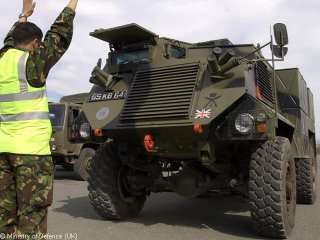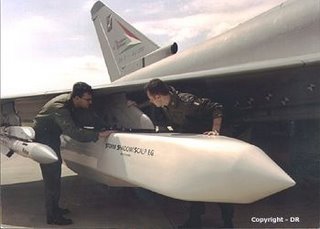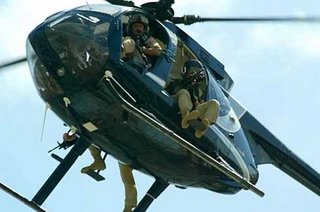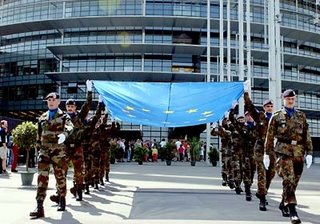 Today, we read in The Daily Telegraph that the Conservatives are concerned that our forces in Afghanistan are under-equipped for their mission.
Today, we read in The Daily Telegraph that the Conservatives are concerned that our forces in Afghanistan are under-equipped for their mission.In a separate piece, we also read that the Army is scrapping 500 Saxon armoured personnel carriers that are unfit for use in Iraq or Afghanistan, but is so short of money that it is planning to replace them with vehicles that are almost 40 years old.
If ever there was a time for saying, "I told you so", it is this. It was two years ago, almost to the day, that I first wrote a piece on this blog about defence equipment plans, noting that the government was planning to spend (then) £6 billion – since increased to £14 billion - on re-equipping the Army with the Future Rapid Effects System.
Presciently, I headed my piece "Another blunder of Eurofighter proportions", introducing a thesis since amplified that the government was preparing to spend huge amounts of money on an untried force structure, all to meet Tony Blair's commitment to providing formations for the European Rapid Reaction Force.
From a limited defence budget, therefore, we were devoting huge sums to feeding a fantasy army while starving our real army, increasingly committed to actual combat, of the equipment and men it needs.
 One of the first pieces of equipment actually to roll off the production lines for this new, fantasy army is the Panther Command Liaison Vehicle, about which we have written at length.
One of the first pieces of equipment actually to roll off the production lines for this new, fantasy army is the Panther Command Liaison Vehicle, about which we have written at length.But what is particularly relevant at this juncture – when the Army is desperately short of a protected patrol vehicle - is that the Panther, at £413,000 each, was purchased against a specification so narrowly drawn that it is useable only for its designated functions. Yet, it was chosen in preference to the RG-31. This was not only £150,000 cheaper but is also a multi-purpose vehicle which could easily have accommodated the Command/Liaison role as well as providing an ideal, protected patrol vehicle.
Currently, the Italian-built Panthers are being finished off by BAE Systems, with the additional of a machine gun, radios and other accessories, when they will be delivered to the Army, effectively providing "battlefield limousines" for Ruperts – as officers are dismissively called – while troops are forced to patrol in dangerously vulnerable "Snatch" Land Rovers.
 Had the decision to buy Panthers, announced in November 2003, been different, we would have had RG-31s rolling off the production lines in British Army colours which, with minor modifications, could be re-fitted as patrol vehicles and shipped out to Iraq and Afghanistan. In the latter theatre, they would be joining the RG-31s operated by the Canadian Army which is so pleased with the vehicles that it has just ordered another 25.
Had the decision to buy Panthers, announced in November 2003, been different, we would have had RG-31s rolling off the production lines in British Army colours which, with minor modifications, could be re-fitted as patrol vehicles and shipped out to Iraq and Afghanistan. In the latter theatre, they would be joining the RG-31s operated by the Canadian Army which is so pleased with the vehicles that it has just ordered another 25.Hindsight, you might say, is easy, but for the fact that the Panther decision always looked suspect and, in the context of a limited budget and an uncertain future, it makes sense to buy a multi-role vehicle, even if it is not absolutely ideal for all of the different tasks for which it might be called upon to perform – more so if, like the RG-31, it is significantly cheaper.
What has happened, though, is that the MoD – under successive governments – has taken its eye of the ball. Obsessed with the idea of constructing a mean, lean, high-tech army, with shiny new toys to impress the European "colleagues", it has neglected the here and now, and the immediate needs of our present-day armed forces, engaged in the messy, bloody counterinsurgency operations for which it is singularly ill-equipped.
 This obsession with shiny (and expensive) high-tech toys – and the prestige they bring - is also another fatal weakness of the MoD, their defence industry pals and the warring tribes within the armed forces. This is behind the decision to buy 900 Storm Shadow air-launched cruise missiles at over £1,000,000 each, the introduction of which was brought forward so that the RAF could indulge in a dick-measuring contest with the Americans during Gulf War II, proving that it too had a stand-off munitions capability.
This obsession with shiny (and expensive) high-tech toys – and the prestige they bring - is also another fatal weakness of the MoD, their defence industry pals and the warring tribes within the armed forces. This is behind the decision to buy 900 Storm Shadow air-launched cruise missiles at over £1,000,000 each, the introduction of which was brought forward so that the RAF could indulge in a dick-measuring contest with the Americans during Gulf War II, proving that it too had a stand-off munitions capability.During that war, the RAF managed to launch 27 missiles at a cost of £29.43 million in weapons alone, compared with the 400 or so US Tomahawk cruise missiles, making no measurable contribution to the campaign and saddling us with a massive bill which we are still having to meet. Yet, in simple terms, the £1 billion for these missiles – the bulk of which are now sitting uselessly in RAF stores – could have bought 4,000 RG-31s. It is not difficult to work out which would be of more use in our current situation.
 Similarly, although there is a massive shortage of tactical helicopters in both Iraq and Afghanistan, as we have recently reported, the government has announced its intention to procure 70 "Future-Lynx" helicopters for £1 billion, to come into service from 2014. Once again, we see this obsession with "high-tech" kit for the future, when the need is here and now.
Similarly, although there is a massive shortage of tactical helicopters in both Iraq and Afghanistan, as we have recently reported, the government has announced its intention to procure 70 "Future-Lynx" helicopters for £1 billion, to come into service from 2014. Once again, we see this obsession with "high-tech" kit for the future, when the need is here and now.But even the £14.2 each to be expended on these aircraft pales into insignificance compared with the £60 million each paid for the Army’s 67 Apache attack helicopters, a squadron of which is currently deployed in Afghanistan. Undoubtedly, they have their value, as attested by a typically "Boy's Own" piece in the Telegraph recently. However, we saw in the Sunday Times, this weekend, a graphic account of a firefight between British troops and the Taliban.
The journalist, Christina Lamb, recounts that, at the height of the battle, the patrol leader, Major Blair, "was very angry indeed". "Where's the f****** air support?" the major was yelling on the radio to British headquarters at Camp Bastion, reading off a GPS position. Lamb continues with the narrative:
"Two A10s 10 minutes away can be with you for 20 minutes," came the reply. Nothing arrived. "We need air support. Where's the air support?" Major Blair radioed again after sliding on his back in another trench, pulled down by the weight of the kit on the mud. The message came back that the A10s had been called off to Sangin, a village to the north where two British special forces had been killed. No other planes were available because heavy fighting was still going on.Now, let's do a little sum. An Apache costs £60,000,000. A Hughes 500 – a light, 4-seater commercial utility helicopter - costs £900,000. For each Apache, you could buy over 60 Hughes helicopters.
 Purists will immediately say that there is no comparison between the two, and indeed there is not. However, in the hands of the private security company, Blackwater Security Consulting, off-the-shelf Hughes 500s, with two door gunners, are used to devastating effect as convoy escorts. Now ask which would have been more use to Major Blair – one Apache committed to a battle elsewhere, or a detachment of four Hughes 500s, on the spot, spitting out fire from eight machine guns?
Purists will immediately say that there is no comparison between the two, and indeed there is not. However, in the hands of the private security company, Blackwater Security Consulting, off-the-shelf Hughes 500s, with two door gunners, are used to devastating effect as convoy escorts. Now ask which would have been more use to Major Blair – one Apache committed to a battle elsewhere, or a detachment of four Hughes 500s, on the spot, spitting out fire from eight machine guns?And yes, I know you can buy such helicopters off the shelf, but it takes two years fully to train a combat helicopter pilot. But how many redundant or under-used helicopter pilots are there currently in the Armed Forces, and how many civilian pilots are there, who were military-trained? And how long would it take to train a pilot to handle a simple machine like a Hughes 500?
So much for the toys, but what about the political implications? These are graphically put by the Telegraph leader which cites Liam Fox, the shadow defence secretary, who told the Commons yesterday, the cost of succeeding could be very high, but the cost of failure would be intolerable. At stake, he says, is the future of both Afghanistan and Nato, under whose aegis the campaign is being waged.
This theme is amplified by Con Coughlin in an op-ed but, like so many, he misses the point. The Army itself, he writes, might be suffering severe overstretch through a combination of underfunding by Gordon Brown's Treasury and Tony Blair's messianic willingness to commit forces to resolve the world's ills…
 No, Mr Coughlin, with the MoD committing £14 billion to FRES, having spent £166 million on its battlefield limousines for Ruperts, having spent £1 billion on Storm Shadow, and billions more on other grandiose European projects – not least committing £30 billion to the Eurofighter - you cannot say there is any underfunding. The real problem is that the Army is suffering from the cumulative effect of bad procurement decisions, which started under the Conservatives' watch but are currently being driven by the Blair government's obsession for European defence integration.
No, Mr Coughlin, with the MoD committing £14 billion to FRES, having spent £166 million on its battlefield limousines for Ruperts, having spent £1 billion on Storm Shadow, and billions more on other grandiose European projects – not least committing £30 billion to the Eurofighter - you cannot say there is any underfunding. The real problem is that the Army is suffering from the cumulative effect of bad procurement decisions, which started under the Conservatives' watch but are currently being driven by the Blair government's obsession for European defence integration.At the moment, it looks doubtful whether the small, under-equipped British force can prevail in a country four times the size of Wales and a border with Pakistan 1,500 miles long, but, as Liam Fox rightly remarked, the cost of failure would be intolerable. Equally, although attention has shifted from there to Afghanistan, the cost of failure in Iraq – where we also have a small, under-equipped force - would be intolerable. Yet, without more troops and more equipment – the right equipment – failure is a distinct possibility.
In fact, failure in either theatre would destroy what little credibility the UK has as a world power. Arguably, to slink out defeated, licking our wounds, would have a greater effect on our standing in the world community than our ignominious departure from Suez. That is what is at stake and the real reason why we are in such a parlous situation is that we have devoted far too much of our energy and wealth to feeding the European fantasy, while neglecting our current responsibilities.
COMMENT THREAD